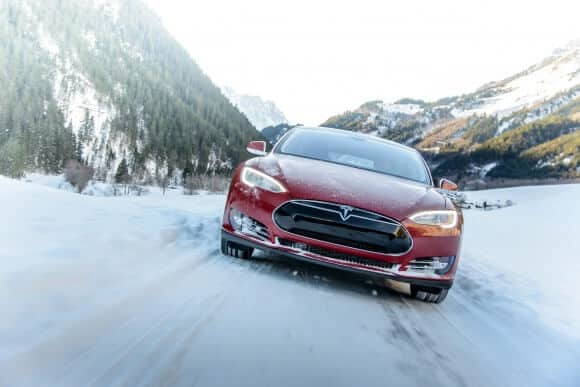Tesla Motors Inc (NASDAQ:TSLA) has a couple of major factors working in its favor. The cumulative cool of the company’s CEO Elon Musk and the silent speed of the company’s Model S Sedan means it never has to spend a cent on advertising, investor belief in the project has made financing easy so far, and the government is helping the company every step of the way.
Tesla Motors is surely grateful for the amount of government subsidies it receives, but the company doesn’t seem keen on recognizing them in its financial accounts. For some reason CFO Deepak Ahuja doesn’t think it wise to include the California Zero Emission Vehicle credits as part of the company’s assets.
Tesla Motors concealing credits
Over at Seeking Alpha on Tuesday, Alberto Zaragoza Comendador wrote about Tesla’s little credit problem. According to the analyst there is no record of the company’s credits from the California Air Resources Board anywhere on the company’s financial accounts. The only exception is when the company sells a portion of the credits, as it did in the third quarter of 2013.
The only mention of the California subsidies for Tesla Motors is mentioned in the risk factors of the company’s earnings releases and SEC filings. Nowhere else does the company make reference to the fact that it makes millions off of what could be counted as a clear intangible asset. For some real insight into the way Tesla Motors handles the ZEV credits, have a look at the full piece here.
The bottom line is that Tesla isn’t explicitly recognizing the benefits it gets from the Zero Emissions Credits schemes across the United States in its financial accounts. That may mean that the company is, in Mr. Zaragoza Comendador’s words, “failed to disclose the impact of regulatory changes affecting the ZEV program,” which “potentially added hundreds of millions to the company’s bottom line.”
The analyst clearly states that Tesla Motors is understating “assets by failing to account for its balance of regulatory credits.”
Asking questions at Tesla Motors
Whether or not a person’s politics lines up with the payment of ZEV credits to Tesla Motors or not shouldn’t matter when discussing whether the company should accurately account for them on its quarterly and annual earnings statements. The company is apparently honest and forthright about vehicle sales and the use of its patents, why isn’t it quite as open in the way it accounts for its California subsidies.
Tesla Motors will reveal its earnings for the first three months of 2015 on May 5. We already know that the company sold 10,030 cars in the three month period, but we can’t be sure about the company’s net benefit from ZEV credits. The way the company dealt with them last year made Chuck Jones, a regular contributor at Forbes, muse about whether the company was stuffing them all into one quarter in order to smooth its financials.
Tesla Motors is never going to be the bastion of transparency that presents itself as in the media. The company’s competitors would be able to do a serious amount of damage with a full breakdown of the company’s costs. With taxpayer money flowing into the firm’s coffers, however, it’s certainly fair to question the company’s use of ZEV credits, the way it accounts for them, and why they don’t appear on the company’s balance sheet.
Trusted & Regulated Stock & CFD Brokers
What we like
- 0% Fees on Stocks
- 5000+ Stocks, ETFs and other Markets
- Accepts Paypal Deposits
Min Deposit
$200
Charge per Trade
Zero Commission on real stocks
64 traders signed up today
Visit Now67% of retail investor accounts lose money when trading CFDs with this provider. You should consider whether you can afford to take the high risk of losing your money.
Available Assets
- Total Number of Stocks & Shares5000+
- US Stocks
- German Stocks
- UK Stocks
- European
- ETF Stocks
- IPO
- Funds
- Bonds
- Options
- Futures
- CFDs
- Crypto
Charge per Trade
- FTSE 100 Zero Commission
- NASDAQ Zero Commission
- DAX Zero Commission
- Facebook Zero Commission
- Alphabet Zero Commission
- Tesla Zero Commission
- Apple Zero Commission
- Microsoft Zero Commission
Deposit Method
- Wire Transfer
- Credit Cards
- Bank Account
- Paypall
- Skrill
- Neteller
What we like
- Sign up today and get $5 free
- Fractals Available
- Paypal Available
Min Deposit
$0
Charge per Trade
$1 to $9 PCM
Visit Now
Investing in financial markets carries risk, you have the potential to lose your total investment.
Available Assets
- Total Number of Shares999
- US Stocks
- German Stocks
- UK Stocks
- European Stocks
- EFTs
- IPOs
- Funds
- Bonds
- Options
- Futures
- CFDs
- Crypto
Charge per Trade
- FTSE 100 $1 - $9 per month
- NASDAQ $1 - $9 per month
- DAX $1 - $9 per month
- Facebook $1 - $9 per month
- Alphabet $1 - $9 per month
- Telsa $1 - $9 per month
- Apple $1 - $9 per month
- Microsoft $1 - $9 per month
Deposit Method
- Wire Transfer
- Credit Cards
- Bank Account



